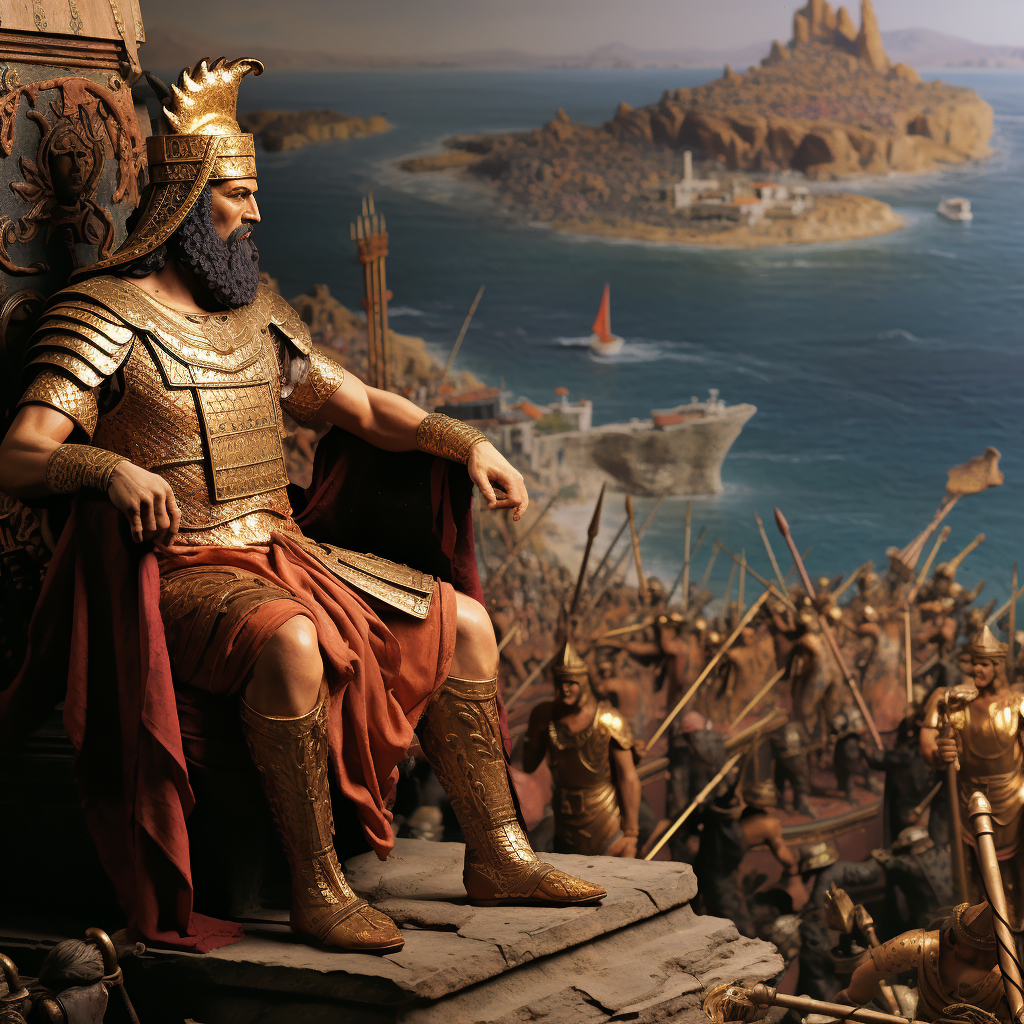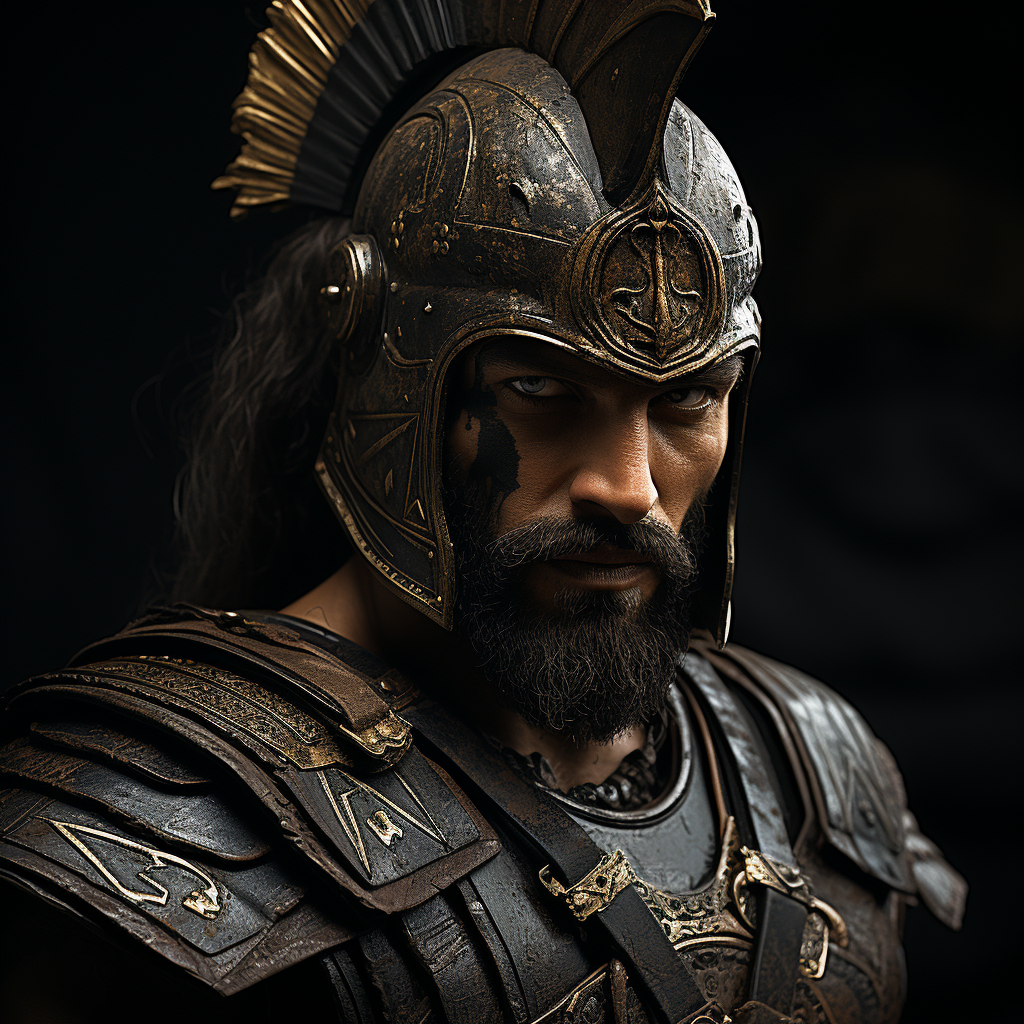Lead up to the Battle of Salamis
The Battle of Salamis was on the horizon. Following closely on the heels of the Greek defeat at Thermopylae and Artemisium, one final conflict was due. They were battered but not undeterred. They moved their armies to the Peloponnese. Seeking solace and regrouping after the relentless onslaught of Xerxes’ Persian forces.
As the sun set on King Leonidas and his 300 Spartans, they had become legends. Their heroism a legacy of history and a rallying cry for the Greeks. But there was no time for grief or basking in glory. Xerxes was relentless, his massive army sweeping through Greece after the Greek defeat.
The Greeks had to regroup, to gather their forces and make a stand. The Battle of Artemisium only provided a glimmer of hope. Yet the strength of the Greek naval fleet was clear. With the Navy under the command of Themistocles, the Greeks inflicted heavy losses and stalled Xerxes. It was a small pause, a chance to catch their breath and plan for the battles to come.
But as the Greeks retreated the full weight of the Persian invasion loomed over them. Xerxes sought to crush the Greek resistance. Doing so would establish his dominance over the Mediterranean. The Greeks faced an uphill battle against an empire that seemed unstoppable.
Yet, they found courage. They knew that their survival hinged on unity and strategy. Themistocles rallied his allies and devised a plan that would exploit the narrow straits of Salamis. They would turn the Persian navy’s size against them. The small space would limit the Persian numerical superiority.
The Battle of Salamis is well known today. It continues to show the importance of good planning and good tactics. Yet, can also be a tale about how ego can lead to ruin.
As the storm of war approached the straight, the Greeks stood on the shores of Salamis, united. With their culture and way of life in the balance, they stood ready. The Persians stood proud, closing in on crushing the Greeks and controlling the Mediterranean. And so, the dye was cast.

Choosing Salamis
Both the Greek and Persian forces braced themselves for the coming fight. Both aware of the stakes of the moment. The air was thick with anxiety, mingled with the salty scent of the sea.
In the Greek camp, a sense of unity and purpose was in the air. The city-states had set aside their differences. Forced to realize that their survival depended on a united front. Under the leadership of Themistocles their ships were a formidable force. The crews prepared themselves for the battle that the greeks wanted. Burning with a mix of fear and resolve, ready to defend their homeland with every fiber of their being.
On the Persian side, Xerxes watched from his throne, confident in the overwhelming might of his fleet. He had a vast armada stretching as far as the eye could see. Yet another display of his empire’s strength. Ships of all sizes and shapes bobbed in the water, manned by soldiers from across the vast Persian realm.
As the sun began to fall, the naval fleets of both sides set sail. The ships gliding through the water like birds in flight. The Greeks used their knowledge of the Aegean sea to positioned themselves in the confines of the straight. Much like a naval version of Leonidas at Thermopylae, using confined space against the Persians. The Persians deployed their ships to display their large numbers. Trying to trap the allies in the straight in one final decisive battle.
As night fell, the sea became a tapestry of flickering torchlights and the distant glow of lanterns. The air was thick tension, a chill felt on the eve of battle. It was a moment frozen in time, where warriors from both sides stood on the edge of greatness or disaster.
And then, in the darkest hours of the night, the stage was set. Xerxes and the Persians would wait till day break. As the sun rose, bringing with it all the life that a new day brings, the battle began. Oars creaked and moaned as rowers urged their ships forward.

First clash
The Battle of Salamis began slow and tedious. The greeks waiting, drawing in the Persians. Finally, the Greeks surged forward. The Greek and Persian ships collided in a dance of death upon the shimmering waves. The crunch of wood and screams of men wailed across the seas. It was chaos. :ives hung in the balance with each pull of oar and splintered hull.
Greek triremes, sleek and agile, maneuvered delicately through the choppy waters. Their oarsmen, pushing the vessels forward with rhythmic strokes. Marines stood poised at the ready to board as needed, their eyes fixed on the enemy. From the decks of the ships, arrows whizzed through the air, finding their marks with deadly accuracy. The Persians struggled to respond to the onslaught.
Amidst the chaos, the Greeks employed the art of ramming. With the speed and agility of their ships, they aimed to strike the sides of the Persian vessels. In doing so tearing through their wooden hulls and sending them to a watery grave. The thunderous impact of ship against ship reverberated through the hulls, rattling the men aboard.
But the Persians were not to be underestimated. Their fleet, vast and imposing, launched volley after volley of arrows, creating a storm of death that rained upon the Greek ships. Arrows found their mark, piercing flesh and leaving men writhing in agony. The Persian commanders urged their troops onward, rallying them to press the attack.
Throughout the day, the battles raged on, the clash of steel and the cries of the fallen echoing across the water. The Greeks fought with desperation, driving forward into their destiny. The Persians, driven by their king’s unyielding command, fought hard.
The Greeks Gain Ground
The Battle of Salamis continued to unfold with the Greeks asserting their advantage. Their ships navigated the narrow straits of Salamis with skill. Weaving through the choppy waters. They outmaneuver the larger Persian fleet.
It was a sight to behold. The Greek triremes, their oars slicing through the water with a rhythmic precision. They closed in on the Persian ships, their movements calculated and deliberate. With each stroke of the oars, they closed the gap, closing in on their prey.
Ramming was the key, and the Greeks mastered it with ruthless efficiency. Their vessels were equipped with reinforced prows designed for maximum impact. They tore through the Persian ships like a predator’s teeth. The collisions boomed, as timber shattered, metal groaned, and men screamed. The sea swallowed the wreckage, claiming it as its own.
But the Persians were not without their own tactics. They unleashed a barrage of arrows and javelins, seeking to rain death upon the Greek ships. The air was thick with projectiles, and the sea became a graveyard of steel.
Yet the Greeks, pushed them back, born for their desire for freedom. They countered the Persian projectiles with their own, archers taking aim from the safety of the ships’ decks. The whistling of arrows filled the air, finding their marks with deadly accuracy. Persian sailors fell, their bodies becoming offerings to the hungry depths below.
As the battle raged on, the sea became a battleground of chaos and carnage. Survival depended on skill and determination, if not luck. The cries of the wounded mingled with the roar of the waves, sounds of death and violence.
And through it all, the Greek naval advantage held strong. Their plan was working and holding firm. Ship after ship fell to their relentless assaults, the Persian fleet weakening with each passing moment. The Persian numbers were turning against them. Their rows of ships were smashing against each other. The tide was turning, and the Greeks sensed victory on the horizon.
The Breaking point
In the chaos of battle, a turning point emerged. The Greeks, buoyed by their successes gained the upper hand. With relentless ferocity, they launched a a final push to drive the Persians back, splitting their forces.
The Greek forces, like a tidal wave crashing upon the shore, surged forward. Their sails flashed in the sunlight, as they pushed their advantage. The Persians, caught off guard by the wedge, faltered in the face of the Greek onslaught.
The Persian commanders, those still alive, now found themselves disorganized. The Greeks fought with might born out of a deep love for their homeland and a burning desire for freedom.
Amidst the chaos, the Persian ranks began to crumble. Their lines fractured as confusion and panic spread through their ranks. The once-disciplined armada now wreckage in the sea.
The Greek attack had caught the Persians off guard, shattering their resolve . Their retreat became a frantic scramble for survival as they tried to flee the wrath of the Greek warriors. The Queen of Halicarnassus, Artemisia attacked and rammed another Persian vessel. Her desire to survive undoing her sense of duty.
As the Persians retreated, the Greeks pursued with an unrelenting fervor. The sound of battle filled the air, punctuated by the clash of swords and the cries of the wounded. The Greeks, fueled by the taste of victory, pressed forward. Refusing to let their adversaries escape their grasp.
Confusion and panic spread like fire within the Persian ranks. Their retreat turned into a rout. A scramble to escape the greek navy. The once-mighty Persian navy now shattered under the weight of its own defeat.
As the dust settled and the sounds of battle faded, a silence fell over the battlefield. The Greeks stood tall, proud of the victory Nike had granted them. The Battle of Salamis and the Greco-Persian War had reached its climax.
Aftermath at Salamis
The final stages of the battle came to a intense drawn down sigh. The Greek warriors chased the Persian fleet back to the safety of their army. Their navy no longer a force in the region.
The Persians had their ranks decimated and their morale shattered. Xerxes struggled with what to do next, even fearing for his ability to cross back into Asia. Their losses were staggering, their once-proud navy reduced to a small supportive fleet. The shores of Salamis were strewn with the fallen and wreckage.
The Greek victory was all but finished. The echoes of battle subsided, replaced by a triumphant silence. The air was thick with the scent of victory and the mingling of saltwater and sweat. The surviving Greeks stood tall, energized with hope that they could win this war.
The once-mighty armada lay in ruins. The waves gently carried the remnants of Persian vessels towards distant shores. an echo of the chaos that ensued in the straight.
The Persian losses were immense, their ships reduced splintered wreckage. With it their dreams of conquest had been crippled. The sea that had once promised them glory had become their undoing.
As the remnants of the Persian fleet retreated, a sense of relief washed over the Greek warriors. The immediate threat had been quelled, and the sea belonged once again to the victors. But the battle’s end marked the beginning of a new phase.
The Battle of Salamis had forever changed the course of the Persian invasion. The Persian forces, once a formidable threat, now recoiled in the face of Greek defiance. The victory had bolstered the Greeks’ determination to defend their homeland.
As the sun began its descent, casting a warm golden glow over the sea, the Greek warriors took a moment to breathe. They stood amidst the wreckage of the Persian fleet, their hearts filled with a mixture of pride and sorrow. The battle had exacted a heavy toll, but it had also cemented their place in history as the victors of Salamis.
And so, the Battle of Salamis enters the pages of history as a monument to the Greco-Persian war. The Greek victory had proven that the spirit of a determined people can always prevail. The Persians, caught in their own ego, now understood the cost of underestimating the Greeks.

Conclusion
In the aftermath of the Battle of Salamis, the sea remained still. Once turbulent waters now hold the secrets of the battles fought.
The Persian assault had been met with a fierce resistance. Rallying after a bitter defeat the greeks held their ground. It was in these moments that the tide had begun to turn. The Greeks utilized their advantages and innovative tactics to turn the tide of the war.
The aftermath of the battle revealed the true extent of the Persian losses. Their mighty fleet lay shattered and broken. The sea, once a domain of Persian conquest, now stood as a symbol of their defeat.
Looking back on the Battle of Salamis, the historical importance is clear. The victory had dealt a severe blow to the Persian invasion and bolstered the Greek sense of national identity. It became the defining moment of the war.
The legacy of the Battle of Salamis continued to reverberate through the centuries that followed. It was the defining moment in a war that drew the lines of cultural diversion. The battle’s historical significance transcended its immediate context. It shapes conflicts in the region through to present day.
And so, we look back on the Battle of Salamis we must remember the price paid. The lasting effects are still seen today. The turbulent waters not calmed rippled through history to all of us.
Deeper Reading:
- “The Battle of Salamis: The Naval Encounter That Saved Greece — and Western Civilization” by Barry Strauss: This book provides a gripping narrative of the Battle of Salamis, exploring its historical context and its significance in shaping the course of Western civilization. Strauss combines scholarly research with accessible storytelling to bring this pivotal battle to life.
- “Salamis: The Greatest Naval Battle of the Ancient World, 480 BC” by Barry Strauss: Strauss delves into the details of the Battle of Salamis, offering a meticulous account of the strategic maneuvers, naval tactics, and key personalities involved. With vivid descriptions and engaging prose, the book paints a vivid picture of the intense conflict and its lasting impact.
- “Salamis 480 BC: The Naval Campaign That Saved Greece” by William Shepherd: Shepherd provides a comprehensive overview of the Battle of Salamis, contextualizing it within the larger Greco-Persian Wars. The book offers a clear narrative, supported by maps and illustrations, allowing readers to visualize the naval engagements and understand the decisive role of Salamis in the conflict.
